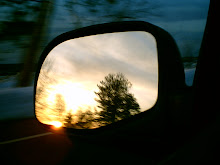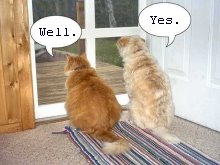The 45th parallel, or "tension line," cuts across northern Wisconsin and north of it, life changes. Tension lifts. Tension shifts. Tension drips away, drop by blessed drop, like tears one is happy to shed.
This may be true only for some, I know.
"Beyond the Tension Line" is my life above the 45th parallel. How the 45th parallel came to be known as the tension line, I don't know, though I did research it, in an admittedly lackadaisical way. It has been suggested that the tension line is biological--that many species of plants and animals have their southern boundary near the line and others their northern limit. This certainly ties in with my idea that certain types of people simply find that they are more comfortable the farther north they go, while others begin to blanch and freak out as soon as the road narrows and buildings fall away.
The 45th parallel is the equivocal halfway point between the equator and the North Pole. Equivocal because, according to a geographical marker on Highway US 41 just south of Peshtigo, Wisconsin, the 45th parallel is only the "theoretical" halfway point, from which one would need to travel a little more than 3,117 miles to reach the North Pole but a little less than 3,098 miles to get to the equator. So the "true" halfway point is actually a bit farther north. (If you're in Michigan on US 41, look for a marker 710 feet north of Menominee. If you're on Highway 141 in Wisconsin, look for a marker three quarters of a mile north of Beaver. And if you're interested in seeing these markers and reading a scientific discussion on this point without having to travel at all, check out this Web site: Halfway to the Pole. If you would prefer a good read about a natural disaster, try Firestorm at Peshtigo: A Town, Its People, and the Deadliest Fire in American History.)
Whether biological, theoretical, or true, there is no doubt that beyond the tension line the world becomes a different place. A place less habituated by humans. A place where life is reduced to two lanes, each going its own way, and whichever way you are going you just might find no one else there or someone going along at a mere 55 miles per hour, someone who, perhaps, is just enjoying the scenery and, you think, slowing you down. Once you have driven beyond the 45th parallel broad open spaces and vast areas of trees--areas that you cannot even identify as "farm" or "country"--take over. These are woods and forests, bogs and clearings, rivers and creeks and lakes. Much of it is national forest. (Allow your eyes to stray far enough north on a map and you'll even notice a 42-mile-long national lakeshore.) All this uninhabited space. You either love it or you are worried to death that you are suddenly going to keel over and die and no one will ever know because there is no one there. Except that old guy in front of you going 50 miles per hour ...
But there is a rich life here. It may take a while, but eventually farms, towns, people become clear. The woods are full of untold stories. It helps to slow down a bit, to take one's time, to wait and see what appears out of the thick of the forest, the deep of the blue, the shadows of a ramshackle barn by the edge of the road. It's up to you whether you slow down or speed on by.
This may be true only for some, I know.
"Beyond the Tension Line" is my life above the 45th parallel. How the 45th parallel came to be known as the tension line, I don't know, though I did research it, in an admittedly lackadaisical way. It has been suggested that the tension line is biological--that many species of plants and animals have their southern boundary near the line and others their northern limit. This certainly ties in with my idea that certain types of people simply find that they are more comfortable the farther north they go, while others begin to blanch and freak out as soon as the road narrows and buildings fall away.
The 45th parallel is the equivocal halfway point between the equator and the North Pole. Equivocal because, according to a geographical marker on Highway US 41 just south of Peshtigo, Wisconsin, the 45th parallel is only the "theoretical" halfway point, from which one would need to travel a little more than 3,117 miles to reach the North Pole but a little less than 3,098 miles to get to the equator. So the "true" halfway point is actually a bit farther north. (If you're in Michigan on US 41, look for a marker 710 feet north of Menominee. If you're on Highway 141 in Wisconsin, look for a marker three quarters of a mile north of Beaver. And if you're interested in seeing these markers and reading a scientific discussion on this point without having to travel at all, check out this Web site: Halfway to the Pole. If you would prefer a good read about a natural disaster, try Firestorm at Peshtigo: A Town, Its People, and the Deadliest Fire in American History.)
Whether biological, theoretical, or true, there is no doubt that beyond the tension line the world becomes a different place. A place less habituated by humans. A place where life is reduced to two lanes, each going its own way, and whichever way you are going you just might find no one else there or someone going along at a mere 55 miles per hour, someone who, perhaps, is just enjoying the scenery and, you think, slowing you down. Once you have driven beyond the 45th parallel broad open spaces and vast areas of trees--areas that you cannot even identify as "farm" or "country"--take over. These are woods and forests, bogs and clearings, rivers and creeks and lakes. Much of it is national forest. (Allow your eyes to stray far enough north on a map and you'll even notice a 42-mile-long national lakeshore.) All this uninhabited space. You either love it or you are worried to death that you are suddenly going to keel over and die and no one will ever know because there is no one there. Except that old guy in front of you going 50 miles per hour ...
But there is a rich life here. It may take a while, but eventually farms, towns, people become clear. The woods are full of untold stories. It helps to slow down a bit, to take one's time, to wait and see what appears out of the thick of the forest, the deep of the blue, the shadows of a ramshackle barn by the edge of the road. It's up to you whether you slow down or speed on by.




